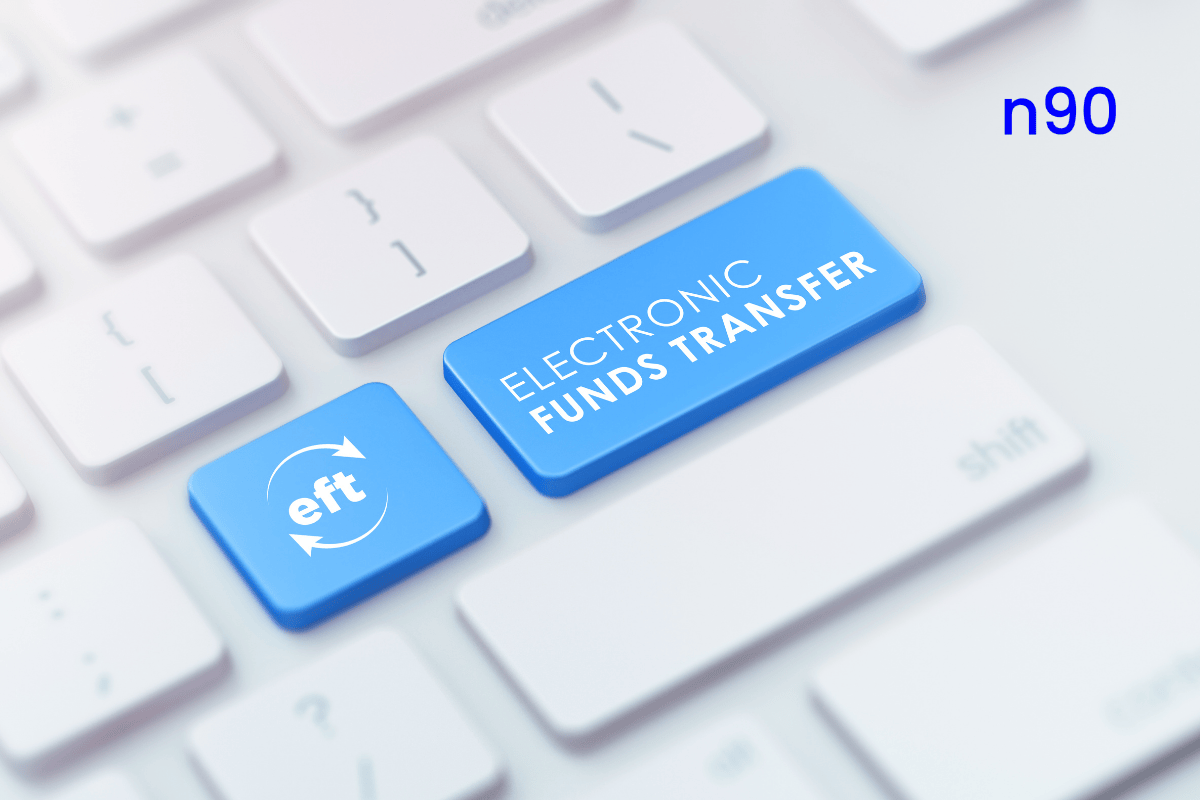The global Digital Remittances market is projected to reach US$273.49 billion by the end of 2025, highlighting the growing shift towards digital payments worldwide.
This trend is gaining significant traction in the Philippines, particularly among small and medium-sized enterprises (SMEs), which are increasingly adopting Electronic Fund Transfers (EFTs) to streamline their financial operations. As an SME owner, understanding how EFT services can improve business transactions is crucial for staying competitive and efficient.
In this blog, we will provide a comprehensive overview of EFT services in the Philippines, exploring key options available to SMEs, their benefits, and the potential challenges you may face.
What is Electronic Fund Transfer (EFT)?
Electronic Funds Transfer (EFT) is the digital money transfer between accounts, typically via an online payment system. This can involve transactions within the same bank or between different financial institutions.
Unlike traditional methods that rely on physical currency or paper checks, EFTs are fully digital, making them faster, more efficient, and more accessible.
EFTs allow individuals and businesses to quickly send and receive funds, streamlining financial processes that were previously time-consuming and paper-dependent. As more financial services shift from paper-based systems to digital, EFT payments continue to grow and evolve, offering more convenient options for managing money.
Key Components of EFT Payments
Electronic Fund Transfers (EFTs) rely on a network of interconnected components that work together to ensure secure fund movement. Understanding these key elements helps you grasp how EFTs function and where responsibilities lie in the transaction process.
- Sender or Originator: The sender initiates the EFT transaction, providing details like the amount and the receiver's account information. This could be an individual or a business transferring funds.
- Receiver: The receiver is the person or organization that receives the funds. After the transaction, the money is deposited into their account and is available for use.
- Financial Institutions: Banks and financial institutions process EFTs by managing fund transfers between accounts. They ensure authentication, verification, security, and regulatory compliance.
- Electronic Channels: EFTs occur through platforms like online banking, mobile apps, ATMs, POS terminals, and payment gateways, offering various ways to transfer funds securely and efficiently.
- Payment Systems: Payment systems, such as ACH, SWIFT, and card networks like Visa and MasterCard, ensure smooth and secure processing of EFTs, including bulk payments and international transfers.
With a clear understanding of how EFTs work and the essential components involved, it's important to explore why this system is especially valuable for small and medium-sized enterprises.
Benefits of EFT for SME Owners
Running a small or medium-sized enterprise comes with constant demands, such as managing operations, handling payments, and ensuring financial accuracy. As businesses require a more innovative, more secure way to move money, Electronic Fund Transfers (EFTs) have become an essential tool.
With the shift toward digital finance, understanding how EFTs can support daily transactions and long-term growth is more relevant than ever. Here are the key benefits.
- Speed: EFTs, especially real-time systems, ensure instant transfers, helping you pay suppliers, process payroll, and manage emergencies without delays, improving cash flow and meeting obligations quickly.
- Convenience: EFTs allow you to make payments anytime, anywhere, using a smartphone, tablet, or computer. This eliminates the need for in-person bank visits or paper checks, giving SME owners a flexible solution for managing payments on the go.
- Security: Digital transfers use advanced security measures such as end-to-end encryption, two-factor authentication, and fraud detection, ensuring safer transactions compared to handling cash or checks.
- Lower Costs: EFTs reduce the costs of paper checks, courier services, and managing cash.
- 24/7 Availability: With EFT systems available 24/7, you can make payments and process transactions outside of traditional banking hours, providing greater flexibility to meet business needs and respond to customer demands anytime.
These are the key benefits of EFTs for SMEs, but to fully take advantage of them, you must choose the right type. Selecting the right EFT helps ensure your payment processes align with your business needs.
Common Types of EFTs in the Philippines
As an SME entrepreneur, dealing with payment delays, administrative hassle, and costly processes can quickly drain your focus and resources. The right solution can streamline operations and keep your business running smoothly.
Exploring the different types of EFTs helps you choose the most efficient method for everything from payroll and supplier payments to customer transactions. Here are some key types.
1. Direct Deposits
Direct deposit is a widely used EFT service that transfers funds directly into a bank account. This method is commonly used for payroll, government benefits, or other regular payments. It relies on networks like PESONet, operated by the Bangko Sentral ng Pilipinas (BSP), to ensure fast and secure transfers.. Direct deposit can also be used for recurring payments like utility bills or subscriptions.
For bulk payments such as payroll and supplier disbursements, PESONet offers same-day batch transfers between banks. Operated by the Bangko Sentral ng Pilipinas (BSP), it's ideal for businesses making high-volume or scheduled transactions. Most banks in the Philippines support PESONet through their online banking platforms.
2. Wire Transfers
Wire transfers enable immediate fund transfers between two financial institutions, typically for large-value or international transactions. These transfers are commonly processed through SWIFT, allowing banks in the Philippines to send and receive international transactions.
While domestic wire transfers can be fast, international transfers may take longer depending on the networks used and time zone differences.
3. Debit and Credit Card Transactions
Card-based transactions are a standard form of EFT in the Philippines, supported by major issuers like Visa, Mastercard, and BancNet.
When you make a purchase using a debit or credit card, you engage in an EFT transaction. The payment is processed electronically, transferring funds from the cardholder’s account to the merchant's account. Systems like chip and PIN, contactless payment technology, or card swiping support this secure method.
4. Mobile Payments
In the Philippines, mobile payment platforms like GCash, Maya, and bank-backed apps using InstaPay allow users to make real-time payments via smartphones. These mobile wallets securely store users' bank account information or cards and enable quick, contactless payments by tapping the smartphone on a reader, much like using a credit card.
5. Bank ATM (Automated Teller Machine)
ATM transactions use bank-issued debit or credit cards to transfer money between accounts or withdraw cash. This form of EFT involves the user interacting with a machine to move money electronically. While ATM withdrawals are common, they can incur fees unless using the same bank's ATM. Some banks also allow deposit transactions through ATMs.
These EFTs are essential in modern financial systems, ensuring secure, efficient, and fast transfers for individuals and businesses. While the different types of EFTs explain how digital transfers generally work, it’s equally important to understand how these methods are specifically applied in the Philippines to cater to SME business and consumer needs.
Popular EFT Services in the Philippines
Electronic Fund Transfer (EFT) services in the Philippines have expanded to support both individual and business needs, from urgent real-time transfers to large-scale, scheduled payments. Below is an overview of the key EFT services available in the country.
InstaPay
InstaPay supports real-time transfers of small amounts between participating banks and e-wallets. It’s most useful for individuals who need to move money instantly, whether for personal or small business purposes.
- Designed for low-value transfers up to ₱50,000 per transaction
- Transfers are completed instantly, 24/7, including weekends and holidays
- Often used for paying individuals, freelancers, small vendors, or moving funds between personal accounts
- Operates under the oversight of BSP and is managed by the Philippine Payment Management Inc. (PPMI)
PESONet
PESONet is best suited for larger, non-urgent transactions. It processes payments in batches and is commonly used by businesses and government agencies.
- Handles high-value or bulk fund transfers
- Transactions are settled on the same or next banking day, depending on cut-off times
- Often used for payroll, supplier payments, and B2B transactions
- Also operated under BSP supervision and managed by PPMI
PESONet aligns with batch payments (similar to ACH or deferred net settlement systems), where transactions are processed in groups, allowing for cost-effective and scheduled payments.
QR Ph
QR Ph enables digital payments using a standardized QR code. It simplifies transactions between users of different banks or wallets by eliminating the need to input account numbers manually.
- Allows both person-to-person and person-to-merchant payments
- Promotes interoperability across financial institutions
- Powered by InstaPay for real-time
- Supports BSP’s financial inclusion efforts through convenient and secure transfers
Mobile Wallet Transfers
Mobile wallets like GCash and Maya offer flexible options for sending money, paying bills, and making purchases through a smartphone.
- Enable wallet-to-wallet and wallet-to-bank transfers
- Operate using InstaPay or similar infrastructure
- Available 24/7 through mobile apps
- Regulated by BSP as Electronic Money Issuers (EMIs)
Digital Commerce Payments
Digital commerce payments refer to online transactions made through e-commerce platforms. These payments often rely on bank transfers or e-wallets to fund purchases.
- Common on platforms like Lazada, Shopee, Grab, and service apps
- Enabled through payment gateways that securely process transactions
- Typically funded by linked cards, bank accounts, or mobile wallets
- Support the growth of the online retail and service sectors
While these popular EFT services in the Philippines offer a wide range of benefits, it’s also essential to recognize the potential challenges that businesses may encounter when utilizing them.
Drawbacks of Electronic Fund Transfers
While EFTs offer speed and convenience, they also come with certain risks and limitations that businesses should be aware of. Understanding these drawbacks can help you plan better, safeguard transactions, and avoid costly mistakes. Here are some common challenges associated with using EFTs.
- Costly International Transfers: International EFTs can incur high fees, including sending and receiving charges, correspondent bank fees, and investigation costs if a transfer is lost.
- Irreversibility of Transactions: Once funds are transferred, especially in wire transfers, they cannot be undone, making it difficult to recover money sent to the wrong person or a fraudster.
- Vulnerability to Fraud and Security Risks: EFTs are at risk of hacking and identity theft, so it's crucial to use strong passwords and monitor accounts regularly to protect financial information.
- Dependency on Technology and Connectivity: EFTs require reliable internet access, which can be a barrier in areas with poor connectivity or when technology fails.
- Limited Recourse in Case of Errors: Mistakes, like entering incorrect account details, may not be easily corrected and can involve delays or additional fees to resolve.
Being aware of these challenges allows SMEs to navigate the complexities of EFTs effectively, minimizing risks and ensuring smoother financial operations as they grow.
Final Note!
Electronic fund transfer services like InstaPay, PESONet, and mobile wallets have reshaped how businesses handle payments, making transactions faster, more secure, and more convenient. For SMEs, these tools help streamline operations, reduce delays, and improve cash flow visibility.
But while EFTs solve payment challenges, many businesses still face gaps in liquidity, especially during growth phases, seasonal demand, or unexpected expenses.
To support these needs, we at n90 offer tailored loan solutions for SMEs in the Philippines. Whether you're looking for short-term funding through Bridge Loans, need structured capital via Small Business Loans, or want to get cash tied up in receivables with Invoice Factoring, our services are designed to match the way your business operates.
With flexible repayment terms and quick disbursements, you can stay financially agile while continuing to optimize your payment processes through EFTs. Apply now or call us at +63 962 663 1393 to explore the right financing option for your growth.
FAQs
1. What are the regulatory requirements for businesses to use EFT services in the Philippines?
A: To use EFT services, SMEs must comply with the Bangko Sentral ng Pilipinas (BSP) regulations. This includes completing Know Your Customer (KYC) procedures, providing valid government-issued IDs, business permits, BIR registration (TIN), and proof of address. For mobile wallets or electronic money issuers (EMIs), businesses must adhere to Anti-Money Laundering (AML) rules and register with licensed platforms regulated by the BSP.
2. How can SMEs integrate EFT systems with their accounting or ERP software?
A: Many banks and fintech providers in the Philippines offer API integrations or downloadable files (like CSV formats) that can sync with popular accounting or ERP platforms such as Xero, QuickBooks, SAP, or NetSuite. This integration helps automate data entry, reconcile transactions in real time, and generate financial reports with fewer errors. Businesses may need the help of a developer or a third-party integration service to automate the process entirely.
3. Are there transaction limits or caps for SMEs using EFT services like InstaPay or PESONet?
A: Yes. InstaPay's maximum transaction amount is ₱50,000 per transfer, with some banks applying daily or monthly cumulative limits based on account type. PESONet doesn’t impose a per-transaction limit, making it ideal for high-value or bulk payments like payroll or supplier settlements. However, banks may apply internal limits, especially for newly opened or unverified accounts.
4. How do EFTs compare with traditional payment methods in auditing and recordkeeping?
A: EFTs offer a clear advantage in terms of audit readiness. Every digital transaction generates an electronic trail that includes timestamps, payer/payee info, and confirmation IDs. This dramatically simplifies tracking, reduces the risk of misplaced records, and speeds up financial audits. Traditional methods like checks or manual receipts often require more documentation and verification.
5. What are the best practices for securing EFT transactions in a small business?
A: To protect your EFT transactions, enforce strict user access controls within your banking or wallet platform. Use two-factor authentication (2FA), enable email or SMS alerts, and avoid transferring over unsecured networks. Regularly review your transaction logs for unusual activity and ensure your devices are protected with updated antivirus software. Partner only with BSP-regulated platforms to ensure compliance and security.













